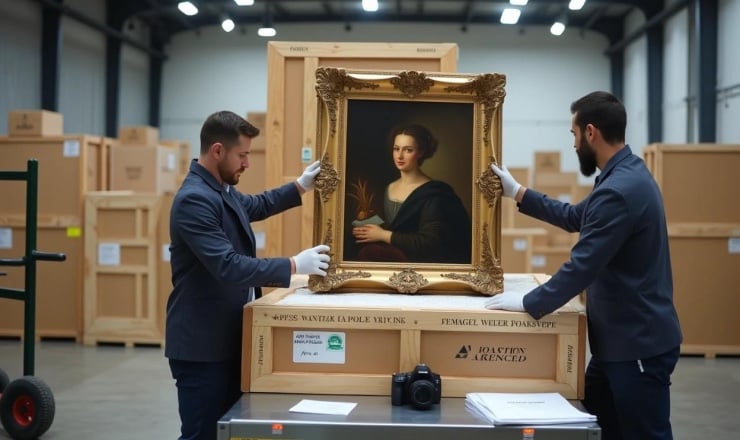Shipping artwork across international borders involves far more than simply selecting a courier. It requires meticulous planning, adherence to strict customs regulations, and an understanding of how to protect valuable, often irreplaceable, pieces. Standard shipping services are rarely equipped to meet these demands.
Art collectors and sellers alike face challenges that go beyond basic packaging and delivery. From regulatory hurdles to environmental sensitivities, international transport demands a thoughtful, professional approach.
This guide outlines a step-by-step approach to international art shipping, from preparing the piece for transport to selecting a trusted logistics partner and ensuring safe delivery. Each section is designed to help protect both the physical artwork and the investment it represents.

Prepare Your Artwork for International Shipping
Preparing artwork for international transport is a critical first step in ensuring it arrives safely and in its original condition. This phase involves more than just wrapping and boxing—it requires thoughtful planning, thorough documentation, and an understanding of the artwork’s unique characteristics.
Proper preparation not only reduces the risk of damage during transit but also streamlines the entire shipping process from pickup to delivery.
Assess the fragility and medium of the piece
A careful assessment of your artwork’s vulnerability to shipping hazards should come first. Research shows that most damage to commercial goods happens during handling, not actual transport. Each medium has specific breaking points:
- Canvas paintings: Medium-sized canvases can suffer damage from minor shocks, especially through “scissoring” movement of stretcher bars
- Panel paintings: Size and mass increase fragility, particularly with deteriorated materials
- Glass-framed pieces: You should always assume glass will break during shipping and pack it so
Document the condition with photos
Good documentation protects you if damage occurs. Art museums report that 50% of transit losses come from improper handling. Your pre-shipping checklist should include:
- High-quality photographs from multiple angles
- Notes on existing flaws, scratches, or damage
- A formal condition report (available as templates from conservation institutions)
- Two copies – one for your records and one with the artwork
This documentation serves as proof of your artwork’s condition before shipping.
Get a professional appraisal if needed
High-value pieces need professional appraisals. You should get an appraisal when:
- Your shipper requires insurance
- The artwork’s value exceeds $50,000 (IRS Art Advisory Panel automatically reviews these)
- You need accurate customs declarations
- The piece holds special historical or artistic value
Note that proper appraisals should be USPAP-compliant (Uniform Standards of Professional Appraisal Practices).
Special considerations for oversized Art
Very large artworks create unique challenges. Collectors who shop oversized canvas art online should plan ahead, as shipping such pieces requires extra care and coordination. Here’s what you need to know about oversized pieces:
- Check aircraft cargo hold dimensions before international shipping
- Some paintings might need removal from stretchers and rolling for transport
- Larger rollers help minimize stress on paint films when rolling becomes necessary
- Custom crating often works better than standard packaging
Note that each extra handling step adds risk, especially for large pieces with embrittled paint layers.
Handle All Required Paperwork and Customs
International art shipping isn’t just about physical transport—it also requires precise administrative work. Navigating the legal and logistical side of cross-border shipments is essential to avoid delays, fines, or even seizure of the artwork.
Understanding and properly managing the necessary documentation ensures a smoother process, protects your investment, and helps maintain compliance with international regulations.
Understand import/export laws for art
Different countries and customs unions have their own unique regulations. The European Union’s 27 member states work together with minimal internal tariffs. The US takes a different approach and maintains its own customs policies. Original artwork usually enters duty-free under specific rules. Original paintings, drawings, and sculptures that artists create entirely by hand can enter the US duty-free under Chapter 97 of the Harmonized Tariff Schedule.
Artwork that’s over 50 years old needs export licenses in many countries because it falls under cultural goods classification. The rules get even stricter when you’re shipping to places like Cuba, Iran, North Korea, Syria, and Sudan – these countries need special licenses.
Fill out customs declaration forms correctly
US commercial shipments valued under $2,500 need CBP Form 7523. Any shipment worth more than $2,500 needs formal entry through a customs broker and an ACE manifest. Personal imports are simpler – you just need to make an oral declaration at the entry point.
Your commercial invoice must include these details:
- Complete description of each artwork
- Accurate value (never undervalue)
- Country of origin
- Recipient’s full details
- Proper EORI number for EU shipments
Use the right tariff codes and invoices
The right tariff codes speed up customs clearance and set duty rates. Here are the main codes you’ll need for art:
- 9701.9100 – Paintings, drawings, and pastels
- 9703.9000 – Sculptures
- 9702.9000 – Original engravings, prints, and lithographs
Commercial invoices are the foundations of international shipping documents. These help foreign customs agencies control imports, determine values, and set duties. Make sure all your documents show the same information.
Select the Best Shipping and Packaging Options
Once all documentation is in order, the focus shifts to the physical handling of the artwork. Selecting the right shipping and packaging approach is critical to preserving the piece’s condition throughout its journey. This stage demands careful attention to materials, methods, and partners to ensure that the artwork is protected from the many risks associated with long-distance transport.
Choose a Trusted International Freight Forwarding Partner
A specialized art shipper plays a vital role in international transport. Services that focus on international freight forwarding offer far more than basic delivery—they provide white-glove handling, climate control, and in-depth customs expertise that standard carriers often lack. These specialized providers deliver project-based solutions such as museum-quality crating, temperature-controlled storage, and personalized courier services.
Companies like Dietl have dedicated teams with specialized knowledge who customize services based on each unique art piece’s requirements. The evaluation of potential partners should focus on their customs clearance experience, international routes, and delicate artwork handling capabilities.
Decide between crate or box based on value
The artwork’s value and fragility determine the right packaging. Quality shipping boxes with proper cushioning are good enough for pieces valued under $500. High-value pieces over $500 need premium art boxes with plastic protectors and foam that offer better protection.
Custom wooden crates serve as the gold standard for high-value international art shipment. These crates offer several advantages:
- Custom-built to artwork dimensions, preventing movement
- Constructed from wood or plywood for maximum durability
- Superior protection against environmental fluctuations
Standard cardboard boxes cost less but provide nowhere near the same protection and work only for lower-value pieces.
Use climate-safe materials and padding
The right internal packaging materials stop damage during transit. Artwork needs wrapping in acid-free, non-adhesive materials like glassine paper or art plastic first. Bubble wrap or soft foam provides the needed cushioning.
Foam fills empty spaces between the crate and artwork to protect against shocks and vibrations. Climate-sensitive pieces benefit from eco-friendly options like moldable cushioning made from recycled paper pulp.
Label with handling instructions
Clear labels prevent mishandling. “FRAGILE” markings should appear on every side of the package. The package needs arrows showing “THIS SIDE UP” and marks on the artwork’s face to ensure proper orientation.
Detailed instructions for unpacking, handling, and repacking the artwork must be included. This helps even inexperienced handlers manage the shipment safely throughout its journey.
Ensure Safe Delivery and Post-Arrival Care
The final stage of international art shipping is just as important as the initial preparation. Once the artwork is en route, maintaining visibility, ensuring proper handoff, and taking post-delivery precautions all contribute to a successful outcome. This phase helps verify that the shipment has been handled correctly and gives collectors or recipients the opportunity to identify and address any issues immediately upon arrival.
Track the shipment in real-time
Up-to-the-minute data analysis becomes vital when shipping valuable artwork internationally. Today’s tracking systems do much more than tell you where your art is:
- Modern shipping companies track temperature, humidity, light exposure, and shock levels right inside the crate
- Specialized devices like Tive Solo 5G Non-Lithium give you global coverage and let you check real-time condition data from anywhere
- These systems help build trust because clients can watch their valuable shipments every step of the way
I get updates on my phone through calls, texts, or video chats that keep me informed about my artwork’s status.
Coordinate with the recipient for delivery
The right coordination with your recipient is a vital part of successful delivery:
You need someone who knows how to handle artwork to be there during delivery. Take enough time to inspect everything properly instead of rushing through this significant step.
The crated painting should adjust for 24 hours before unpacking if there’s a big temperature difference between shipping and destination conditions.
Inspect the package before opening
Delivery time is the most important point in your shipping experience:
- Don’t accept delivery if the crate shows any damage. This makes the shipping company and gallery quick to fix the problem.
- Your phone can record everything – from opening the crate to taking out the artwork. Get close-up shots of damaged spots and include something like a measuring tape to show size.
- Keep all packing materials and document how everything was packed before you start unwrapping. Sometimes the wrong packing materials can damage your art.
Make this final inspection an absolute must in your international art shipping process, whatever shipping partner you choose.
Conclusion
International art shipping involves a series of critical decisions that impact both safety and success. Each phase—preparation, documentation, transport, and delivery—requires attention to detail and an understanding of industry standards. Cutting corners increases the risk of delays, damage, or loss, which can jeopardize the artwork’s condition and value.
A structured approach helps maintain control throughout the journey. Clear documentation, protective packaging, and experienced logistics partners all contribute to a secure outcome. With the right steps in place, valuable artwork can move across borders with confidence and care.
We hope you found this blog post How to Ship Art Internationally: Guide for Art Collectors, useful. Be sure to check out our post Tips For Packing Your Fragile Items Safely for more great tips!
Have Experience in the Moving Industry? Want an Additional Income Stream? Work With All Around Moving!
Earn a commission with all the moving jobs you book with All Around Moving Company. Partner with us and we’ll help you profit as a moving relocation consultant. Click here to learn more.





